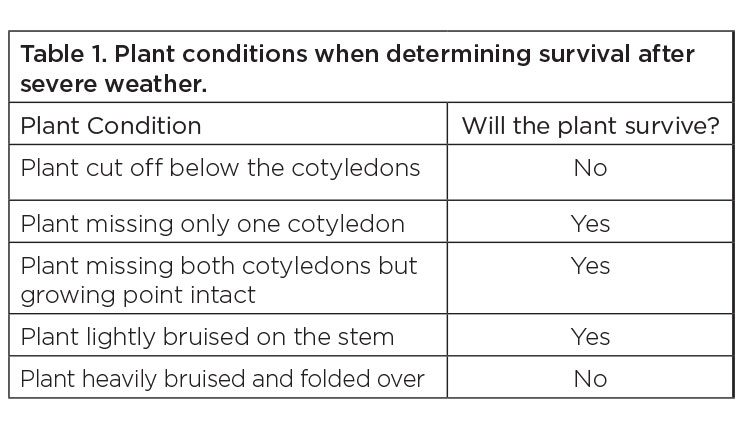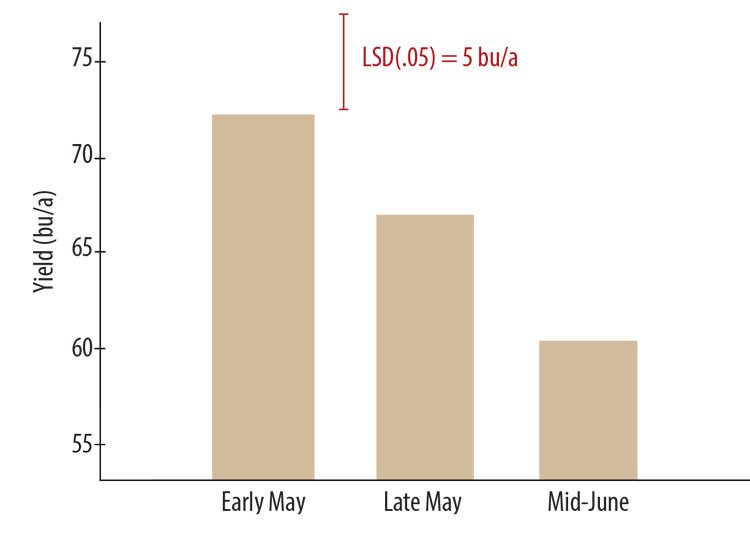Adam P. Gaspar, Shawn P. Conley, & John M. Gaska, Deptartment of Agronomy, University of Wisconsin-Madison
About the Author
Adam Gaspar is a graduate student in the Department of Agronomy at the University of Wisconsin, Madison, working under Shawn Conley, pursuing a doctorate in agronomy. His current research and Extension activities include many aspects of modern, Midwest soybean and wheat production. Gaspar’s research is very applied in nature and the resulting extension is targeted at the farm level where producers can immediately adopt research findings. The goal of my research is to increase crop production in an environmentally and economically sustainable fashion by improving crop management through the adoption of new practices and technologies.
Introduction
Soybean planting date trends have steadily shifted earlier within the Northern Corn Belt while inclement weather, insect pressure and disease pressure associated with spring planting can require replanting some years (USDA-NASS, 2011). Furthermore, recent studies have reported similar yields among reduced plant stands due to the soybean plants compensatory ability (Carpenter and Board, 1997) and diminished yield potential of replanted or essentially later planted soybeans (Conley et al., 2012; De Bruin and Pedersen, 2008). Ultimately, producers would like to know the potential yield gain or loss from replanting sub-optimal plant stands to help determine if replanting is economical. Therefore the objectives of this study were to:
• Determine the threshold for replanting soybean stands.
• Evaluate replanting options.
• Quantify the effect of seed treatments and planting date on replant decisions.
This study was conducted in 2012 and 2013 at the Arlington Agricultural Research Station, Arlington, Wis. Twelve different replant scenarios were planted in 15-inch rows during early May, late May, and mid-June. The replanted portions of the plots were interseeded between the rows of the initial soybean stand. ApronMaxx RFC and CruiserMaxx (Syngenta Crop Protection) seed treatments were used to compare a fungicide only seed treatment with one that also contains an insecticide.
Determine the Initial Plant Stand
The first step in making an informed replant decision is determining the initial plant stand. Soybean stands can be deceiving to the eye sometimes, especially in narrow rows (<15 inch), where stands can be greatly underestimated. Therefore, using the hula hoop method or counting the number of plants in a row is needed to accurately determine the plant stand. If severe weather causes stand reduction and/or plant injury, stand counts should be performed three to five days after damage has occurred to give the plants time to recover. Only live plants that are expected to survive should be counted (Table 1).
Counting Plants in a Row
When determining the plant stand with this method, count the number of plants in a length of row based upon your row spacing (Table 2). Do this at least five times in different areas of the field and calculate the average, then multiply that number by 1,000 to get the number of plants per acre (plant stand).
Hula Hoop Method
When determining the plant stand with this method, randomly toss any round hoop with a known diameter on the ground and count the number of plants within the hoop. Do this at least five times in different areas of the field and calculate the average, then multiply that number by the appropriate multiplier (Table 3) to get the number of plants per acre (plant stand).
Replant Threshold
Our study showed that the highest yields were achieved with initial plant stands >100,000 plants per acre (Figure 1). This is consistent with Lee et al. (2008), who stated soybeans in Kentucky require plant stands above 100,000 plants per acre to achieve 95 percent of maximum yield. This is further demonstrated by the initial seeding rates of 40,000, 60,000, and 80,000 seeds per acre with no replanting, which produced final plants stands well below 100,000 plants per acre and yielded 10, 5, and 4 bushels per acre less than the maximum yield, respectively (Figure 1). However, when these same plant stands were filled in and the final plant stands were subsequently increased above 100,000 plants per acre; significant yield increases of 7, 2, and 2.5 bushels per acre were attained, respectively (Figure 1). Replanting initial soybean stands <100,000 plants per acre significantly increased yield, but not to levels attained by initial plant stands >100,000 plants per acre, where replant is not beneficial. Therefore, the threshold for soybean replanting is 100,000 plants per acre.
Replanting Options
When below threshold soybean stands arise (<100,000 plants per acre), producers are faced with the decision to fill in the initial stand or perform a tillage operation and completely replant the entire stand. Our study found that a tillage operation limited yield potential by essentially delaying planting and reducing cumulative light interception of the entire stand compared to only a portion of the stand when the fill in method was used (Gaspar and Conley, 2014). In Figure 1, we see that when the initial plant stand was reduced to zero (by tillage), replanting with up to 220,000 seeds per acre only significantly increased yield over a final plant stand of 37,000 plants per acre. However, when this plant stand was filled in with only 100,000 seeds per acre, its yield was the same or higher than replanting the entire stand with 220,000, 180,000, and 140,000 seeds per acre (Figure 1). Furthermore, final plant stands >59,000 plants per acre produced similar or higher yields compared to using tillage and replanting with 220,000 seeds per acre (Figure 1). Therefore, filling in soybean stands below the replant threshold (100,000 plants per acre) is the best method of replanting and replant seeding rates should be high enough to increase the final plant stand over 100,000 plants per acre. Figure 2 depicts a stand with 37,000 plants per acre being filled in with 100,000 seeds per acre.
Seed Treatment and Planting Date Effects on the Replant Decision
We observed no effect of seed treatment use on replant decisions and therefore should not be a factor considered. However, seed treatment use (especially insecticide/fungicide treatments) may help avoid replanting because it is an effective management practice for increasing initial plant stands stands by 20 percent on average (Gaspar et al., 2014).
Our study indicated a large yield decline as planting was delayed past the first week in May (Figure 3). This yield decline is most likely due to decreased light interception of later planted or replanted soybeans. The earliest planting date yielded 73 bushels per acre (Figure 3). We observed a 0.25 bushels per acre per day yield decline between the early May and late May planting dates, which then doubled to 0.5 bushels per acre per day between the late May and mid-June planting dates. The average yield decline through the whole planting season was 0.32 bushels per acre per day. However, the replant decision was not affected by planting date and therefore the replant threshold (100,000 plants per acre), method (fill-in), and seeding rates (>100,000 plants per acre) are appropriate until June 20 in southern Wisconsin. Replanting past this date greatly increases the risk of fall frost damage (Conley and Gaska, 2013).
Conclusion and Recommendations
The first step in deciding if replanting is required is to determine the initial plant stand. Our study demonstrated that replanting soybean stands below the threshold (100,000 plants per acre) by filling in the existing stand, increased yields regardless of the date (May-June 20) and seed treatment use. Below threshold plant stands should be filled in with enough seed to bring the final stand above 100,000 plants per acre. Using tillage and replanting the entire stand greatly limited yield potential, even at replant seeding rates of 220,000 seeds per acre. This is due to the entire plant stand being replanted or essentially planted later, which reduces yields by 0.32 bushels per acre per day on average. These replant recommendations are applicable through June 20 in southern Wisconsin, where replanting after this date is not advised. Traditionally, the notion of adequate weed control has led producers to desire higher plant stands to quickly shade out competing weeds. However, pre-herbicide use and modern post herbicide technology has essentially eliminated this concern. This study only evaluated soybean replanting in terms of yield and did not take into account the economics of a replant decision, which include additional seed, fuel, labor, and machinery costs; along with potential crop insurance replant payments. Producers should consult their crop insurance agent before making any replant decisions. Ultimately, the producer’s efforts should be placed on using this data in conjunction with their own finances to determine if replanting will increase economic return.
In addition, Gaspar has taken this research and developed a smart phone-tablet app that will guide producers to an informed replant decision based upon a few entered inputs and a picture taken with the app of a fields plant stand. This app will be released spring of 2016.
References
Carpenter, A.C. and J.E. Board. 1997. Branch yield components controlling soybean yield stability across plant populations. Crop Sci. 37:885-891.
Conley, S.P. and J.M. Gaska. 2013. Considerations for switching soybean maturity groups for delayed plantings. Accessed Feb. 15, 2014 from <www. coolbean.info>.
Conley, S.P., E.M. Cullen, V. Davis, P. Esker, and C. Laboski. 2012. Soybean yield limiting factors in Wisconsin. Coop. Ext. Serv. Univ. of Wisconsin-Madison. Madison, WI.
De Bruin, J.L. and P. Pedersen. 2008. Soybean seed yield response to planting date and seeding rate in the upper Midwest. Agron. J. 100: 696-703.
Gaspar, A.P. and S.P. Conley. 2014. Impacts of modern agronomic practices and replanting on soybean seed yield and crop canopy measurements. Crop Sci. (in review).
Gaspar, A.P., S.P. Conley, and P.D. Mitchell. 2014. Economic risk and profitability of soybean seed treatments at reduced seeding rates. Crop Sci. (in review).
Lee, C.D., D.B. Egli, and D.M. TeKrony. 2008. Soybean response to plant population at early and late planting dates in the Mid-South. Agron. J. 100:971-976.
USDA-NASS. 2011. Historical soybean percent planted. Accessed Jun. 15, 2012 from <www.nass. usda.gov>. Confirmed on Feb. 15, 2014.



















